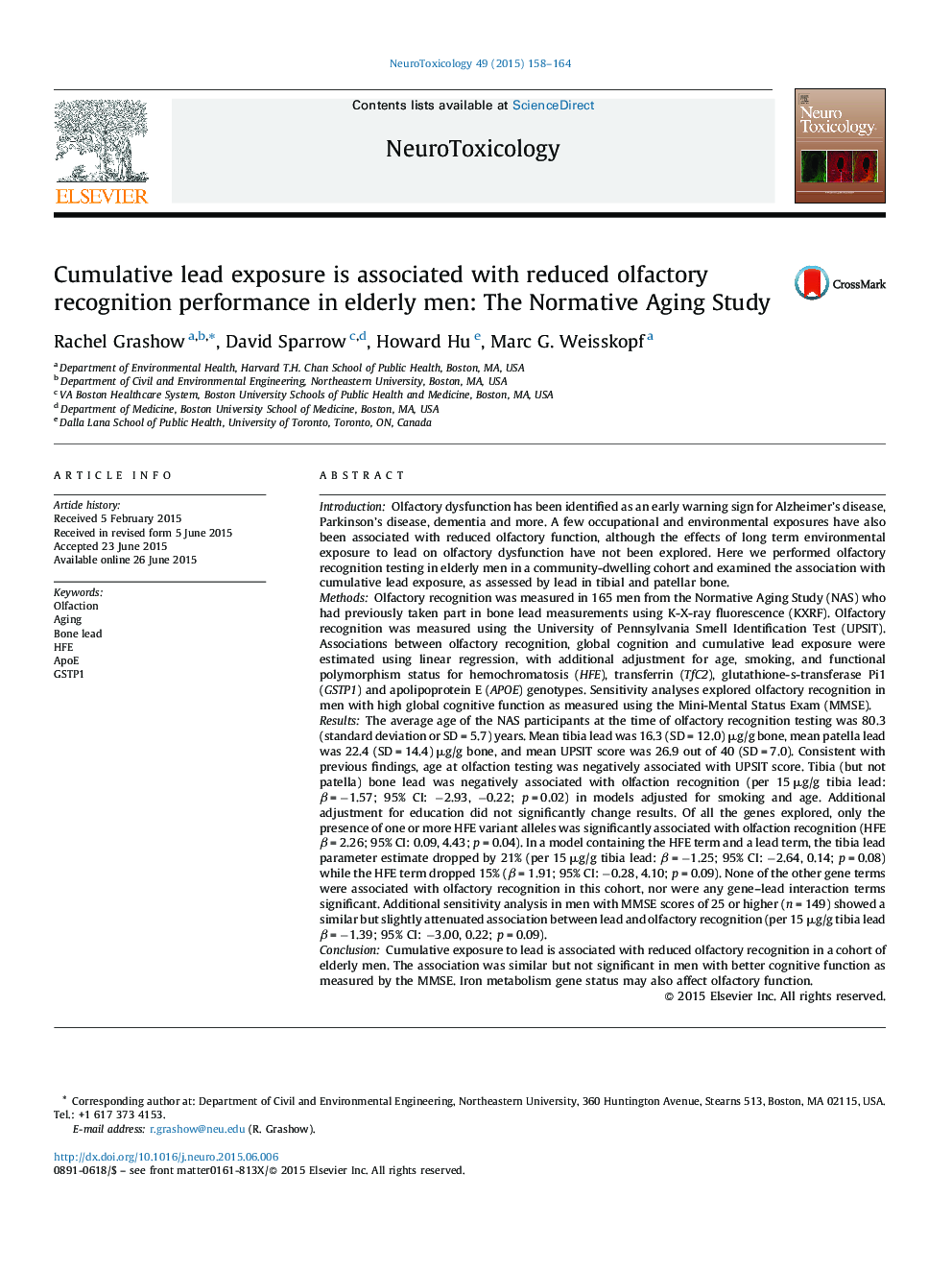| کد مقاله | کد نشریه | سال انتشار | مقاله انگلیسی | نسخه تمام متن |
|---|---|---|---|---|
| 2589562 | 1562045 | 2015 | 7 صفحه PDF | دانلود رایگان |
• We explored olfactory recognition in elderly men with environmental exposure to lead.
• Higher tibia lead was associated with reduced olfactory recognition performance.
• Variant HFE allele status was associated with improved olfaction recognition.
• APOE-ɛ4, GSTP1 and TfC2 were not associated with olfactory recognition.
• Lead exposure and iron metabolism gene status may affect olfactory recognition.
IntroductionOlfactory dysfunction has been identified as an early warning sign for Alzheimer's disease, Parkinson's disease, dementia and more. A few occupational and environmental exposures have also been associated with reduced olfactory function, although the effects of long term environmental exposure to lead on olfactory dysfunction have not been explored. Here we performed olfactory recognition testing in elderly men in a community-dwelling cohort and examined the association with cumulative lead exposure, as assessed by lead in tibial and patellar bone.MethodsOlfactory recognition was measured in 165 men from the Normative Aging Study (NAS) who had previously taken part in bone lead measurements using K-X-ray fluorescence (KXRF). Olfactory recognition was measured using the University of Pennsylvania Smell Identification Test (UPSIT). Associations between olfactory recognition, global cognition and cumulative lead exposure were estimated using linear regression, with additional adjustment for age, smoking, and functional polymorphism status for hemochromatosis (HFE), transferrin (TfC2), glutathione-s-transferase Pi1 (GSTP1) and apolipoprotein E (APOE) genotypes. Sensitivity analyses explored olfactory recognition in men with high global cognitive function as measured using the Mini-Mental Status Exam (MMSE).ResultsThe average age of the NAS participants at the time of olfactory recognition testing was 80.3 (standard deviation or SD = 5.7) years. Mean tibia lead was 16.3 (SD = 12.0) μg/g bone, mean patella lead was 22.4 (SD = 14.4) μg/g bone, and mean UPSIT score was 26.9 out of 40 (SD = 7.0). Consistent with previous findings, age at olfaction testing was negatively associated with UPSIT score. Tibia (but not patella) bone lead was negatively associated with olfaction recognition (per 15 μg/g tibia lead: β = −1.57; 95% CI: −2.93, −0.22; p = 0.02) in models adjusted for smoking and age. Additional adjustment for education did not significantly change results. Of all the genes explored, only the presence of one or more HFE variant alleles was significantly associated with olfaction recognition (HFE β = 2.26; 95% CI: 0.09, 4.43; p = 0.04). In a model containing the HFE term and a lead term, the tibia lead parameter estimate dropped by 21% (per 15 μg/g tibia lead: β = −1.25; 95% CI: −2.64, 0.14; p = 0.08) while the HFE term dropped 15% (β = 1.91; 95% CI: −0.28, 4.10; p = 0.09). None of the other gene terms were associated with olfactory recognition in this cohort, nor were any gene–lead interaction terms significant. Additional sensitivity analysis in men with MMSE scores of 25 or higher (n = 149) showed a similar but slightly attenuated association between lead and olfactory recognition (per 15 μg/g tibia lead β = −1.39; 95% CI: −3.00, 0.22; p = 0.09).ConclusionCumulative exposure to lead is associated with reduced olfactory recognition in a cohort of elderly men. The association was similar but not significant in men with better cognitive function as measured by the MMSE. Iron metabolism gene status may also affect olfactory function.
Journal: NeuroToxicology - Volume 49, July 2015, Pages 158–164
